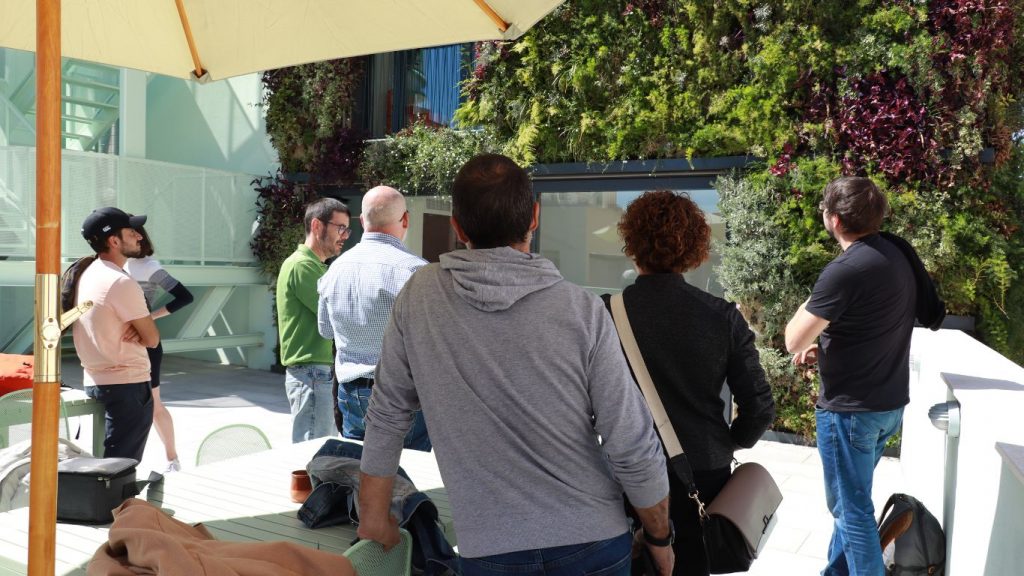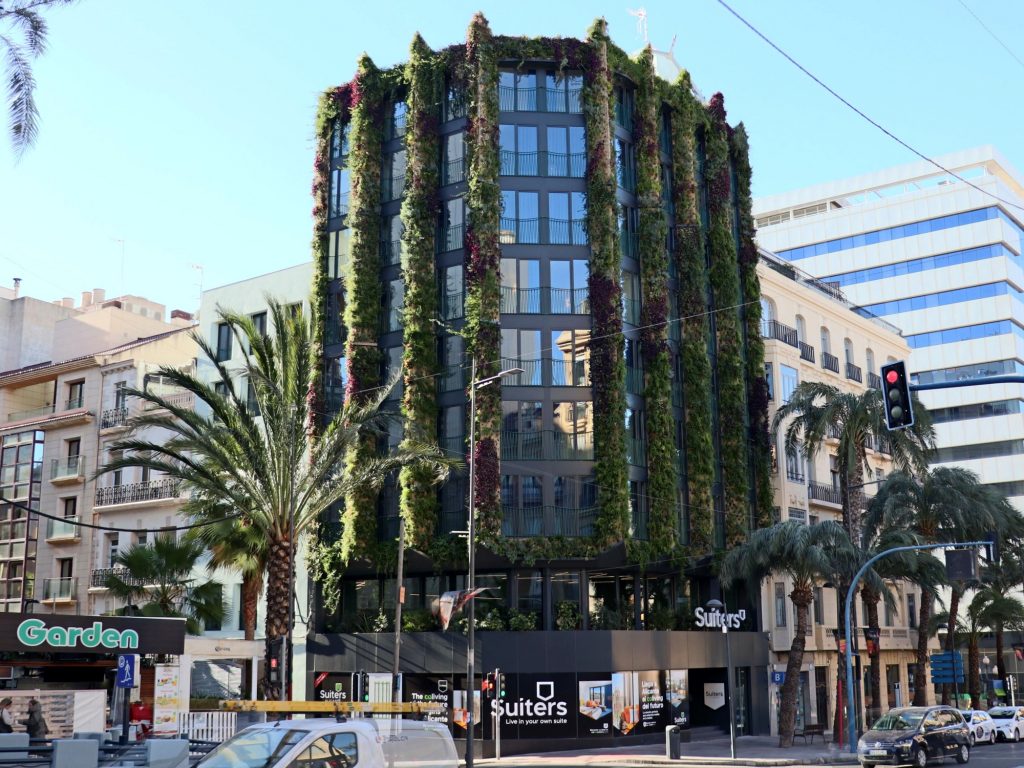- Want to learn how to create a green oasis in your home? A vertical garden course may be just what you need.
- Looking to improve or expand your knowledge as a design or gardening professional? A vertical garden course may be just what you need.
- Do you want to improve air quality and reduce heat load in urban areas? A green walls course will show you that this solution is a very interesting option to achieve these goals.
Just as there are different types and systems of vertical gardens, you will also find on the market both classroom and online courses to teach you how to design, build and maintain one.
In this article you can explore a variety of options for vertical garden courses and projects.
Types of vertical gardens or green walls
There are several types of vertical gardens to suit different needs and tastes:
Vertical gardens with hydroponic systems.
Vertical gardens with hydroponic systems are those that do not need soil to grow, as the roots of the plants are supported by a nutrient and water solution flowing through an inert substrate. These systems offer several advantages, such as efficient use of water and the possibility of growing plants in places where there is no fertile soil.
Vertical gardens with pockets
Another option are vertical gardens with pockets (textile or other material), systems that use individual pots for the plants. These systems are a good option for those who want a small-scale modular design that is easy to maintain, as it is possible to replace individual plants.
Vegetable roof gardens as a garden
Roof gardens are known as green roofs, or green roofs, and are those that are placed on top of buildings and real estate.
Unlike conventional vertical gardens, which are hung on a wall, roof gardens are planted horizontally and often provide a larger growing area and better sound and heat insulation to the building.
However, as they have different growing requirements (horizontal), they must be treated from a different technical point of view in order to avoid problems (green roof course).
If you are interested in this type of training, the most important thing to know is the basics of all the options available and when and why to choose each one and not only the products of the training provider.The next thing you can and should consider is whether it is better to take an on-site or online vertical garden course.
We personally believe that both have advantages because in the classroom courses synergies are generated, a lot of knowledge is condensed and the doubts of some enrich everyone. On the other hand, the online methodology has the advantage of being able to go at your own pace and be able to repeat the sessions as many times as you need or refresh your knowledge from time to time.
On-site course on vertical gardens
In addition to offering online courses, the company SingularGreen also offers classroom courses in Madrid, Barcelona and Alicante to learn how to design and build vertical gardens.

Information about the courses in Madrid, Barcelona and Alicante
SingularGreen’s classroom courses in Madrid and Barcelona last three days and are aimed at people interested in acquiring knowledge about vertical gardens and green roofs in the most practical way possible.
In these courses, students will learn first-hand about the different vertical garden systems (not only the systems offered by the company).
They are also taught installation techniques, maintenance and design of these gardens, as well as the use of the tools and materials necessary to build a vertical garden. The classroom courses are given in small groups to ensure personalised attention from the teachers, and take place in both theoretical classrooms and practical fields.
Information about courses in Argentina, Mexico and Bolivia
SingularGreen also offers face-to-face courses in Argentina, Mexico and Bolivia, aimed at people interested in learning about vertical gardens in Latin America. In these courses, students will learn about the particularities and needs of vertical gardens in the region, as well as the most appropriate construction techniques and systems.
The courses are held on different dates throughout the year in each of these countries and to obtain all the necessary information about them, it is possible to contact us directly by writing to cursos@singulargreen.com
Green walls online course
If you are interested in learning about vertical gardens from the comfort of your own home, there are many online options that can provide you with the knowledge you need. Here are two online course options so you can learn about vertical gardens from anywhere, and at your own pace.
SingularGreen Course Description
SingularGreen offers a comprehensive online course, with more than ten hours of videos and over 200 pages of downloadable material. This course is aimed at architects, engineers, gardeners, builders and other professionals interested in the subject.
The course content is divided into several parts:
- Introduction to the world of vertical gardens
- Systems and structures for vertical gardens
- Analysis of the environment and choice of plant species
- Construction of a vertical garden
- Maintenance and care of a vertical garden
Each part has a detailed description and a series of videos explaining the theory and showing practical examples of each step of the process. In addition, SingularGreen offers expert support and assistance for the duration of the course.
The course is priced at 300 euros, and access does not expire, so you can access the materials as many times as you wish. You also have the option of taking the course in the classroom format. This will allow you to attend one of the face-to-face courses that SingularGreen carries out in any of the cities where the course is scheduled to take place for a reduced price.

Design and construction of vertical gardens
Vertical gardens are an excellent option for those looking to incorporate nature into their home or workplace. In this section, we will delve into the materials needed to build a vertical garden, the basic knowledge of gardening and landscaping necessary for its design and the proper techniques to maintain its watering and fertilisation.
Tools and materials needed to build a vertical garden
To build a vertical garden, it is necessary to have specific materials that allow the stability of the plants and the proper circulation of water.
- Growing bags
- Cuttings or seedlings
- Substrate or soil suitable for cultivation
- Automatic or manual irrigation systems
- Supporting elements to fix it on the wall or in the chosen place.
Each type of vertical garden – such as hydroponic or pocket gardens – may require specific materials. It is important to take these into account before starting construction to ensure the stability and durability of the vertical garden.
Basic gardening and landscaping knowledge
Like any other type of garden, the construction of a vertical garden requires some basic knowledge of gardening and landscaping. Some important aspects are:
- Identification of plant species and their specific care needs.
- Combining colours and textures in the arrangement of the plants.
- The choice of plants according to the place where the vertical garden will be placed.
For this purpose SingularGreen has created mini-capsules that you can buy for a reduced price.
Watering and fertilising techniques
Watering and fertilisation are fundamental for the success of a vertical garden. Some techniques to take into account:
- Watering and fertilising according to the specific needs of the plant species.
- Maintaining the right light and humidity conditions
- Use of automatic watering systems for better efficiency.
With these techniques, the proper care of the plants and the sustainable development of the vertical garden will be guaranteed.
Maintenance of vertical gardens
The maintenance of a vertical garden is key to maintaining its beauty and health in the long term. This section details the care required for these plant structures and offers solutions to common problems that can affect them.
Care needed to keep a vertical garden healthy and attractive
- Watering: It is important to water the vertical garden regularly, making sure that all plants receive the right amount of water. To do this, it is recommended to use drip irrigation systems or sprinklers that completely cover the plant wall.
- Feeding: Plants need nutrients to grow healthy and strong. In vertical gardens, the use of liquid or granular fertilisers is recommended, applying them from time to time according to the needs of the plants.
- Pruning: It is necessary to prune plants to prevent them from becoming excessively long or dense, and to remove damaged or diseased parts. Clean and precise tools should be used to avoid damaging the plants.
- Pest control: Pests can be a common problem in vertical gardens, so continuous monitoring is necessary to detect any problems and apply appropriate treatments.
Troubleshooting common problems in vertical gardens
Watering problems
- Excessive watering: Excessive watering can cause moisture problems in the wall and put the structure of the plant wall at risk. To avoid this situation, follow the guidelines and take into account the needs of each plant species.
- Lack of water: Insufficient watering can dry out the plants and cause the leaves to turn brown or yellow. To avoid this, it is recommended to use efficient irrigation systems adjusted to the needs of the plant wall.
Lighting problems
- Excessive sunlight: In areas with a lot of sun exposure, it is common for plants to sometimes get burnt and dry out. To alleviate this problem, different materials can be used or plants can be protected with shading nets.
- Lack of light: When plants do not receive enough light, their growth will be affected and flowering will be poor. In such cases, artificial lighting systems can be installed with LED lamps adapted to the needs of the plants.
Pests and diseases
- Mites: Mites can affect vertical gardens, especially in hot, dry climates. Continuous monitoring of the plants is recommended to detect any problems and apply appropriate treatments.
- Fungi: Fungi can appear in situations of excessive humidity in the plant wall. This problem can be prevented by maintaining proper drainage and ventilation.
In general, the maintenance of a vertical garden requires constant attention and specific care depending on the species chosen and the conditions of the site. By following the care and troubleshooting recommendations outlined in this section, you can enjoy a healthy and attractive plant wall.
Projects and examples of vertical gardens
Characteristics of the largest outdoor vertical garden in Spain
The plant façade has a total surface area of 1492m2, of which 1000m2 is a vertical garden with the hydroponic f+p system and 492m2 are climbing plants that cover the windows.
More than 33,000 plants of different varieties native to the area of Alava and the Basque Country have been used for planting.

The main reason for the project was to improve the energy consumption of the Congress Centre, the proposed vertical garden system: ‘F+P Preplant’ adds a thermal resistance of 2,644m2.K/W. This means 270% more insulation over the existing façade, with the consequent energy savings.
Canal de Isabel II vertical garden
This vertical garden in Madrid has an area of approximately 240 m² divided into 3 sectors. As you can see in the image below, on the far right, we wanted to transfer the logo of the Canal de Isabel II company to the garden design, which we joined to a whole network of curved lines that was perfect for this type of design.
Durability is one of our main objectives, which is why we selected the F+P system. This system is composed of a substrate capable of withstanding humidity for a longer period of time and also allows the installation of any variety of species.
Real success stories and design recommendations
The selection of the plants to be used is one of the specific criteria for each project. It is always important to opt for the autochthonous flora of natural and forest areas, transferring the plant structures that exist naturally in these areas to the façade.
To do this, the first step we take is to carry out an exhaustive study of the existing forest and native flora in the city. Once visited and studied in detail, we generated a list of almost 50 plant species.
The second step was to apply the general criteria that we always apply in SingularGreen when making a list of plants for vertical gardens. These are:
- No use of invasive exotic species
- Use of autochthonous species, from families close to these or commonly used in vertical gardens in similar climates.
- Use of species adapted to the climatic conditions of the city and to the specific orientation of the different facades.
- Use of low maintenance species in terms of watering, pruning, pest and disease control.
To these 4 general criteria we add an extra request from the property: the addition of climbing species to cover the balconies of the façades. In other words, the final surface area to be covered with vegetation will be greater than the one specified in the future, as soon as the climbers colonise all the balconies (which they will).

One of the recommendations when designing a vertical garden is to take into account the climate of the area where it is going to be installed.
For example, for very sunny areas, it is recommended to use plant species that can withstand high temperatures and droughts. In addition, it is important to analyse the type of soil and the height of the building in order to choose the right irrigation system and the right location for the plant species.
Another important aspect in the design of vertical gardens is the choice of the type of fixing system for the plant species and the substrate to be used. There are different fixing systems, such as hydroponic, panel or modular, and various substrate options, from synthetic substrates to organic substrates, such as compost or sphagnum moss.
Importance of vertical gardens
Vertical gardens have multiple benefits for our society and for the environment.
Some of these benefits include improving air quality, reducing the impact of urban heat, reducing noise and increasing biodiversity in urban areas. In addition, they also have economic benefits, as they can increase the value of real estate.
Recommendations for future projects and developments in the field of vertical gardens
In order to further advance the field of vertical gardens and improve their positive impact on society, it is important to continue researching and developing new design and construction techniques.
It is also essential to raise public awareness of the benefits of vertical gardens and to promote their use in urban spaces.
Finally, collaboration between different sectors, such as architecture, engineering and botany, should be encouraged to create more innovative and successful projects.
Specific recommendations could include:
- Encourage the creation of vertical gardens in public and private buildings.
- Develop educational programmes so that the population has access to information on the construction and maintenance of vertical gardens.
- Promote research on new construction techniques and sustainable materials for vertical gardens.
- Create green spaces in urban areas where there is no natural vegetation.
- To carry out more scientific studies on the benefits of vertical gardens and their impact on people’s health.
Do you want more information about a vertical garden course?
Fill in the form and we will contact you.






